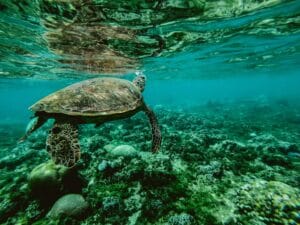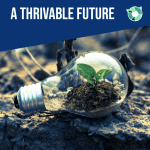Beyond Boundaries: How Land and Water Ecosystems Are Connected
There is an intrinsic link between the land and all waterways. The air, land, and water cycles influence each other. The continuous movement of water through each of these cycles is important for planetary health (NASA, n.d.). Evaporation, transpiration, condensation, and runoff are some of the terrestrial water cycle processes that affect aquatic biodiversity. Air moves water around the planet in the form of clouds. Water on land flows to groundwater sources, including underwater aquifers, before evaporating and returning to the land (USGS, 2018). In this way, aquatic and terrestrial ecosystems are dependent on each other. This is an example of Strong Sustainability, a Foundational Focus Factor (FFF) of THRIVE, concerned with the natural environment and the management of its processes.

The Role of Terrestrial Animals in Regulating Water Health
Many terrestrial animals perform regulatory functions that directly benefit aquatic ecosystems (Dahlin, 2021). Herbivores grazing along waterway banks maintain aquatic vegetation, preventing erosion and stabilising the banks as well as maintaining terrestrial plant densities around waterways (Queensland Government, 2025). Animals also filter the water to remove sediment, nutrients, and pollutants through a method of feeding called filter feeding. This then improves the biodiversity of the aquatic ecosystems, creating a more sustainable ecosystem and improving the lives of aquatic animals (Shah et al., 2022).
Frogs are a great example of species important to water quality regulation. Frogs are important semi-aquatic creatures that are essential for waterway health. They are a keystone species, meaning if they disappear from the ecosystem, the ecosystem would be in danger of collapse (Hoefer and Stars, 2016). They (adults and tadpoles) regulate algae levels, reduce natural pollutant levels, maintain insect population levels, and serve as important prey for many aquatic and terrestrial species. However, they are also sensitive to outside pollutants and changes in ecosystem health. For this reason, they are indicator species, as their presence denotes healthy waterways.
Pollution and Runoff: When Land-Based Biodiversity Declines
Pollution is a leading cause of both terrestrial and aquatic system decline. Agricultural runoff from fertilisers, pesticides, and herbicides, is a significant issue when it runs into waterways. Once in the waterways, it alters the sediment levels, pH, clarity, and nutrient content, creating algal blooms and reducing the ability of light to penetrate the water. Where it does not kill aquatic creatures, it causes reproductive failure or birth defects (Hall, 2024). Riparian vegetation, the vegetation associated with waterways, can help prevent this by absorbing the runoff, however, the levels of pollutants used often harms this vegetation (Nahhar and Nahhar, 2021). This runoff also causes long-term land degradation, with the chemicals potentially staying in the soil for weeks (NOAA, n.d.). With less vegetation present, waterway erosion often occurs. The affected waterways are then unsuitable for both terrestrial and aquatic animals until the chemicals break down and the ecosystem can heal.
To combat the issue of runoff, better management practices and waste management on farms and in industrial areas must be implemented to ensure runoff into aquatic ecosystems does not occur. Real-time monitoring of waterways can help detect levels of nitrates and other nutrients before they reach critical levels, allowing for measures such as farming/industrial restrictions or water treatment plans (Hall, 2024).
Forests, Fauna, and Freshwater: The Riverbank Connection
Water movements, and temperature, through the landscape are influenced by: landforms, soil types, vegetation types and density, animal movements, and human activities (Fondriest, 2014). The topography of the environment affects runoff patterns, channeling pollution, while the soil type determines the absorption rate of chemicals in the ground, with some holding a greater volume of pollutants. Vegetation, particularly forests, can intercept rainfall and affect evaporation rates, preventing water from reaching the ground, reducing runoff, and increasing transpiration, essential for the water cycle. While plants reduce ground evaporation, they increase evaporation from plants, retaining more water in the soil and improving soil health (BOM, n.d.).
Healthy waterways also aid terrestrial ecosystems by acting as wildlife corridors, allowing animals passage between ecosystems, increasing diversity in wildlife. These corridors create a means of migration, colonisation, and diversification of plants and animals (Global Evergreening Alliance, 2024). The deforestation of these corridors and along riverbanks has great effects, not only to wildlife, but to ecosystems, as they provide stability, prevent pollution, and provide habitats. Riparian ecosystems are often more diverse than those away from water sources (Dugdale et al., 2024).
Food Web Linkages: Cross-Ecosystem Species Interactions
Aquatic animals provide a food source for terrestrial animals, and changes in terrestrial biodiversity can directly affect aquatic biodiversity. Healthy marine ecosystems regulate the climate, improving the survival of terrestrial ecosystems. Should a terrestrial ecosystem decline, it would negatively affect nearby aquatic ecosystems owing to the links between them. As a result, less food would be available, ecosystem processes would be under strain, and the biodiversity would decline(Dahlin et al., 2021).
Migratory animals who require passage through ecosystems, depend on the health of both terrestrial and aquatic ecosystems to find water, food, shelter, and protection from predators. These species have important roles and act as dispersal agents for seeds and nutrients, allowing for improved genetic diversity and biodiversity (Bauer, 2014).
Salmon, for example, will travel up freshwater streams from their ocean homes to spawn, bringing saltwater-derived nutrients, enriching the freshwater ecosystems, and promoting terrestrial biodiversity. They also act as an important food source and remove excess nutrients from the streams as they travel. The decline of salmon populations indicates a decline in the quality of the environment in which they live (Kaeriyama and Sakaguchi, 2023).
Protecting Both Worlds: Why Biodiversity Conservation Must Integrate
Integration of both terrestrial and aquatic ecosystems is essential for sustainability and mitigating climate change. Little attention is paid to the links between terrestrial and aquatic environments. However, these systems are intricately intertwined, with declines in one inevitably creating declines in the other. Both biodiversity and the climate rely on terrestrial ecosystems as well as aquatic ecosystems to function properly. Biodiversity conservation must integrate into everyday thinking to aid all ecosystems and prevent the degradation of ecosystems. Context-Based Metrics determine levels of human impact and regulate the impact on ecosystems. They are important for environment regulation, showing when levels change and when intervention for ecosystem health is required. Biodiversity must be maintained in both terrestrial and aquatic ecosystems. This ensures natural processes can occur, equating to a healthy planet.
Biodiversity maintenance is particularly important owing to the current threat of climate change (UN, 2025). Healthy ecosystems are one of the planet’s best defences against climate change. Climate change is one of the biggest threats to biodiversity worldwide, if not the biggest threat. Habitual conservation of our natural resources must become the standard to ensure the future of our planet. Science-Based Targets use research to set environmental goals that are a measure of ecosystem health and biodiversity levels.
Conclusion and Call to Action (CTA)
It is essential that more focus is given to the strain put on nature by humanity in the name of progress. Ecosystems across the world are struggling owing to the threats caused by climate change, pollution, and deforestation. These ecosystems have intrinsic links; when aquatic ecosystems are affected, it affects terrestrial ecosystems and vice versa. Terrestrial species play an integral role in maintaining aquatic ecosystems and communities, through filter feeding and nutrient cycling, to population control and erosion mitigation. Aquatic ecosystems are affected by terrestrial biodiversity, and many species act as indicators; they show the health of the ecosystem through their population numbers.
Progress on ecosystem health and the revitalisation of ecosystems is an important step in achieving sustainability. SDG15: Life on Land and SDG14: Life Below Water are two Sustainable Development Goals (SDGs), created by the United Nation, linked to ecosystem health. They are concerned with improving biodiversity, however, these goals not not sufficient. Achieving sustainability should be the bare minimum of the world’s targets, not the goal. Instead we must focus on achieving thrivability. A state where humanity thrives alongside nature. Where both humans and nature live harmoniously without causing detriment to the other.
Achieving THRIVE goals
Achieving the twelve Foundational Focus Factors (FFFs) of THRIVE, The Holistic Regenerative Innovative Value Entity, is imperative to a future that goes beyond sustainability, to thrivability. One of these FFFs, Strong Sustainability, has a direct connection to ecosystem health. Strong Sustainability is concerned with ensuring sustainability is not just met, but exceeded, thus creating a healthy planet for future generations. Context-Based Metrics should be used to measure human impact on these ecosystems, while Science-Based Targets are useful tools to monitor biodiversity levels and ecosystem health. These FFFs are important in maintaining biodiversity and ensuring progress towards thrivability.
A Thrivable Framework
To learn more about thrivability, head to the THRIVE website. Here, you can find published articles covering many topics. There are also whitepapers and presentations on a range of thrivable topics. Resources can also be found on the THRIVE YouTube channel. Be sure to sign up for the newsletter and attend the monthly webinars to learn more. Online workshops occur every month. Be sure to register to attend. To make a significant contribution to THRIVE, consider volunteering today.




















